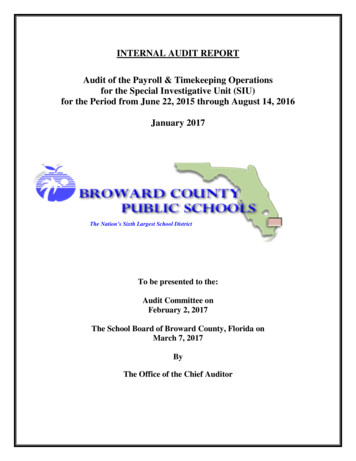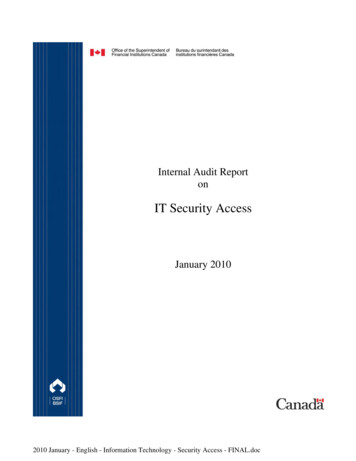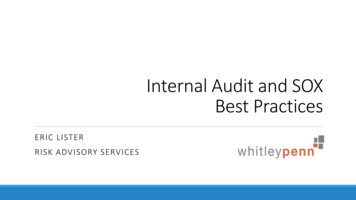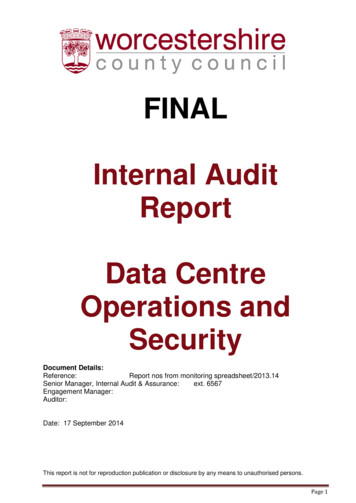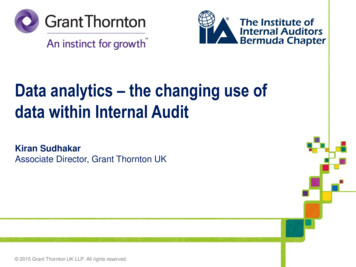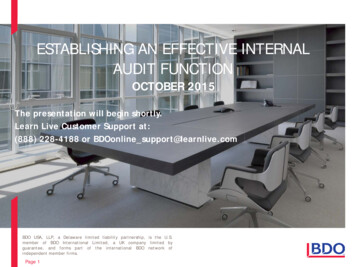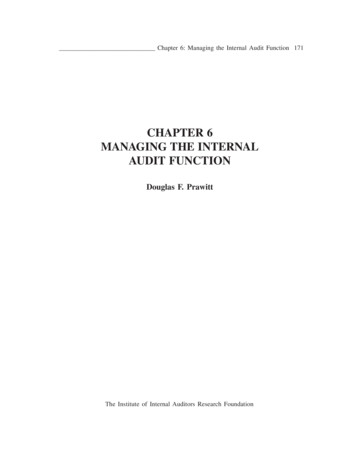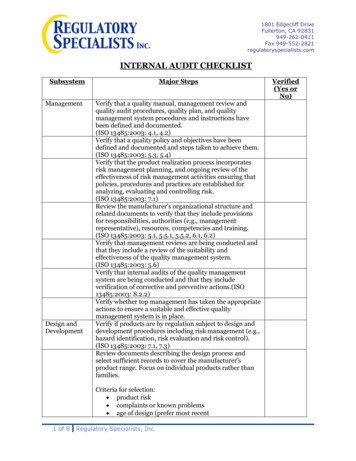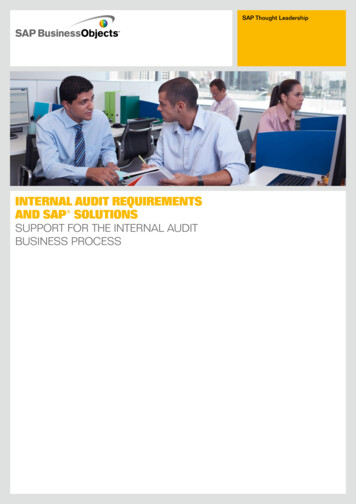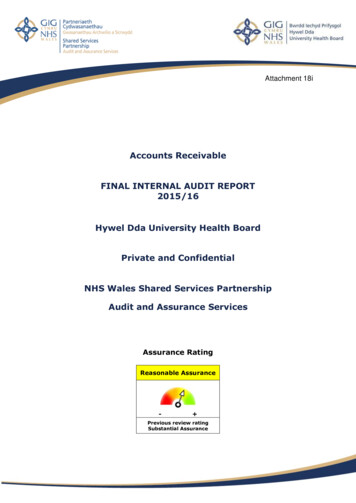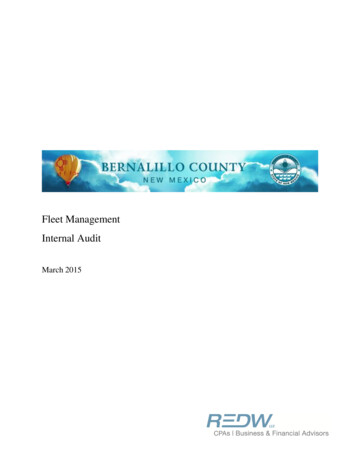
Transcription
Fleet ManagementInternal AuditMarch 2015
Bernalillo County Internal AuditFleet ManagementExecutive SummarySUMMARY OF PROCEDURESREDW performed an internal audit over Fleet Management at Bernalillo County. Our internalaudit focused on testing various policies and procedures and internal controls, including: vehicleacquisition, reassignment and disposal, security of fleet data, monitoring of fuel consumption,vehicle repair and maintenance, and accountability of auto parts.We performed the following procedures: Obtained an understanding of operational procedures through reading relevant FleetManagement documentation and interviewing various personnel. Tested vehicles that were purchased in fiscal year 2015 (July 2014 to March 2015) todetermine if approvals were obtained, and vehicles were added to systems on a timely basisfor maintenance and fixed asset tracking. Obtained the vehicle usage report and determined if low usage vehicles were reassigned asneeded. Tested a sample of reassigned or disposed vehicles, equipment and units to determine ifrequired documentation was completed and support was maintained for the sale, ifapplicable. Tested employees with access to the Fleet Management M5 software system to determine ifaccess was disabled timely. Tested fuel consumption reports for accuracy and timeliness of submission. Analytically tested a sample of vehicles for mileage reasonableness. Tested a sample of vehicles to determine if repairs and maintenance were completed timelyand required documentation was completed. Tested a sample of work orders to determine if sourcing of auto parts followed establishedprocedures. Tested a sample of count sheets for auto parts maintained at the Fleet facility to determine ifcounts were completed regularly with support to indicate investigation of differences, ifapplicable.i
SUMMARY OF OBSERVATIONS AND RECOMMENDATIONSWe found areas during the course of the audit where controls were functioning properly andestablished procedures were followed. We determined that the overall amount budgeted forvehicle purchases in fiscal year 2015 had been properly approved, the budgeted amount had notbeen exceeded and vehicles were added to the Fleet Management system for proper trackingwithin a reasonable timeframe. Vehicles that were reassigned or disposed met the qualificationsfor mileage or age as outlined in Fleet guidelines.Significant high and moderate risk observations are presented below: Monitoring of Fuel Consumption—The Fleet department prepares quarterly reports andprovides those to Departments; however, there was no process to track or investigate unusualfuel activity or trends. Additionally, 14 of the 22 vehicles tested from the Fuel Usage reporthad mileage entry errors. A formal process should be implemented and documented with acentralized person to ensure all departments are conducting their reviews and investigations. Accountability of Auto Parts at the Fleet Facility—Low value assets, such as auto partsmaintained at the Fleet Facility, should be properly accounted for and tracked with a monthlyphysical count. For the months of November 2014 and January 2015 physical counts werenot completed. Additionally, for two physical counts tested, count documentation did notinclude complete information with resolution of differences identified. A documentedprocess should be established to maintain accountability of auto parts.The lower risk observations are included in the attached detailed report.* * * * *Further detail of our purpose, objectives, scope, procedures, observations, and recommendationsare included in the internal audit report. In that report, management describes the correctiveaction taken for each observation.We received excellent cooperation and assistance from the Fleet Management Departmentduring the course of our interviews and testing. We sincerely appreciate the courtesy extended toour personnel.Albuquerque, New MexicoApril 16, 2015ii
Bernalillo County Internal AuditFleet ManagementTable of ContentsPageINTRODUCTION1PURPOSE AND OBJECTIVES1SCOPE AND PROCEDURES PERFORMED2OBSERVATIONS, RECOMMENDATIONS AND MANAGEMENT RESPONSES4
Bernalillo County Internal AuditFleet ManagementReportINTRODUCTIONWe performed the internal audit services described below solely to assist Bernalillo County inevaluating the internal controls over selected processes relating to Fleet Management functions.Our services were conducted in accordance with the Consulting Standards issued by theAmerican Institute of Certified Public Accountants, Generally Accepted Government AuditingStandards, and the terms of our contract agreement for internal audit services. Since ourprocedures were applied to samples of transactions and processes, it is possible that significantissues related to the areas tested may not have been identified.An entrance conference was held on March 12, 2015, and fieldwork began the weekof March 16, 2015. An exit conference was held on April 8, 2015, and final managementresponses were received on April 16, 2015.Although we have included management’s responses in our report, we do not take responsibilityfor the sufficiency of these responses or the effective implementation of any corrective action.PURPOSE AND OBJECTIVESOur internal audit focused on evaluating whether processes were in place to monitor compliancewith Fleet Management requirements and to determine if those processes were in compliancewith policies and procedures (P&P), applicable regulations, and reflected best practices andsound internal controls. We assessed the security of Fleet data, as it relates to the M5 software,which is a fleet management system used to track vehicles and equipment. Additionally, weevaluated vehicle acquisition, reassignment and disposal of vehicles and equipment, vehiclerepair and maintenance, all of which are managed through the M5 software. We also evaluatedthe monitoring of fuel consumption, and accountability of auto parts at the Fleet Managementfacility. The Fleet Management department maintains auto parts at their facility of items that areregularly used. They also source parts from both the Inventory Warehouse managed by theProcurement and Business Services Department, as well as directly from vendors.1
SCOPE AND PROCEDURES PERFORMEDIn order to gain an understanding of the processes and operations surrounding FleetManagement, we interviewed the following personnel: Dwight Coleman, Fleet Administrator Jared Divett, Fleet Shop SupervisorIn order to understand policies and procedures over the Fleet Management processes weread relevant portions of: The Bernalillo County Fleet Operating Policy and Procedures dated June 1997; and, The Bernalillo County “Draft” Fleet Management / Maintenance Standard OperatingGuidelines dated June 2015.We performed the following testwork:Vehicle Acquisition: We obtained supporting documentation for approvals to purchase vehiclesfor the fiscal year 2015 (July 2014 to June 2015). We obtained the listing of all County vehiclestracked in the M5 system as of March 2015. We assessed whether vehicles purchased in fiscalyear 2015 through the date of testing were added to the M5 system for proper monitoring.Additionally, we obtained the listing of all vehicles in the County's Fixed Asset module in SAP,the County’s enterprise software for recording financial data. We tested to determine if: Required approvals for the purchases were obtained. Amount approved agreed to vehicles purchased. Vehicles were added to M5 timely after purchase. Vehicles were added to SAP timely for asset tracking.Reassignment or Disposal: We obtained the listing of all County vehicles and equipment withtheir assigned locations as of January 2015 and select a judgmental statistical sample of 22disposals or reassignments (based on 90% Confidence Level (CL) and 10% Tolerable Deviation(TD) from a total population of 243 units) and tested to determine if: The Vehicle Decommissioning Form was completed and maintained. The Diagnostics Evaluation Form with determination to either reassign or sell the vehiclewas completed and maintained. Fleet communicated the determination to the County’s Fixed Assets Section for reassignmentor disposal. The vehicle met requirements for reassignment or disposal listed in the Fleet StandardOperating Guidelines. Support for sale of vehicle, or other support was maintained to determine that it was properlydisposed, if applicable.Additionally, we obtained the “Vehicle Usage” report from the M5 system as of March 2015 toassess for vehicles identified with low usage based on annual mileage and average monthlymileage driven to determine whether the vehicle should be reassigned.2
Security and Access to Fleet Data: We obtained the listing of all users for the WEX Fuel Cardsystem and the M5 system as of January 2015. We also obtained the listings of all activeemployees and terminations as of January 2015 from the Human Resources Department andtested to determine if users identified with access to Fleet systems were active employees withthe County. Additionally, we assessed whether terminated employees had access disabled andthat no activity occurred after the termination date.Monitoring of Fuel Consumption: We obtained the “Fuel Report by Department” for the 1stquarter and 2nd quarter of fiscal year 2015. We tested to determine if: Quarterly reports were submitted timely to designated reviewers (County Manager, DCMsand Department Directors). Data included in the report could be traced and agreed to supporting documentation. Issues identified had been investigated with documentation maintained to support resolution.We also obtained the “Fuel Usage” report from the M5 system for the period of December 2014through February 2015. We then judgmentally selected 22 vehicles listed in the report (based on90 CL / 10 TD from total population of 847 units). We then scanned the transactions for the 22vehicles for mileage data entry errors.Vehicle Repair and Maintenance: We obtained the listing of all active County vehicles as ofJanuary 2015 and the listing of master parts maintained at the County’s Procurement andBusiness Services inventory warehouse as of January 2015. We selected a random statisticalsample of 22 vehicles (based on 90 CL / 10 TD from a total population of 1,319 vehicles) andtested to determine if: The vehicle’s preventive maintenance service was completed timely. For the last preventive maintenance or repair service performed: The work order was completed and entered to M5 accurately including the parts used. The vehicle checklist (inspection) form was completed and notes were transferredaccurately to M5. If condition documented appeared to be due to an incident, determined whether therequired Risk Management forms had been completed. Parts identified as used in the work order were ordered through the established process.Sourcing of Auto Parts: We obtained a listing of the auto parts activity by work order from theM5 system for the period of August 2014 through January 2015 and selected a judgmentalstatistical sample of 22 work orders (based on 90 CL / 10 TD from a total population of 1,622work orders). We tested to determine if the parts were ordered from the inventory warehouse, ifavailable, in accordance with the established procedures.Additionally, we obtained the listing of expenditures for fiscal year 2015 from M5 by unit(vehicles and equipment). We selected all units (eight units) with maintenance or repairexpenditures greater than 20,000 and tested that they were active in use units and theexpenditures were supported.Accountability of Auto Parts at the Fleet Facility: We requested all inventory counts performedin the period of August 2014 to January 2015 and tested four of the six months to determine if:3
A physical count was performed and documented. Reconciliation to expected system counts was completed and documented. Variances were investigated and resolution documented. Counts and changes to quantities were verified by an independent employee.Additionally, we obtained change reports from the M5 system to determine if quantities changedin the system agreed to the counts completed. We also scanned the report for any changes thatappeared unusual and requested explanations.OBSERVATIONS, RECOMMENDATIONS AND MANAGEMENTRESPONSESWe identified the following weaknesses relating to the Bernalillo County’s processes:1) Monitoring of Fuel ConsumptionThe Fleet department prepares quarterly reports and provides those to Departments; however,there was no process to track or investigate unusual fuel activity or trends. Additionally, 14 ofthe 22 vehicles tested from the Fuel Usage report had mileage entry errors.Potential Risk: Moderate—Mileage updates to vehicle records in both the M5 and WEXsystems are dependent on manual data entry and are susceptible to error or could be falsified.Fleet relies on departments to monitor for unusual trends and there was no process forinvestigating, documenting and communicating issues identified which could result in excessfuel consumption going undetected.Recommendation: A formal process should be implemented and documented to includemonitoring for consumption and discrepancies, analyzing fuel usage and mileage for eachvehicle, reporting data consistently to the identified parties, investigating and documentingresolution of issues identified. The County should include in this process who is responsible foreach part of the process as it will likely result in various departments working together; however,a centralized person should be identified who will ensure all departments are conducting theirreviews and investigations.Additionally, Fleet is currently researching a system that tracks mileage automatically whichwould eliminate the possibility of errors in the mileage data. Once mileage is accurate, miles pergallon by vehicle should be analyzed to identify unusual trends.Management’s ResponseFleet/Facilities Management Department
Fleet Management Report INTRODUCTION We performed the internal audit services described below solely to assist Bernalillo County in evaluating the internal controls over selected processes relating to Fleet Management functions. Our services were conducted in File Size: 336KBPage Count: 13
